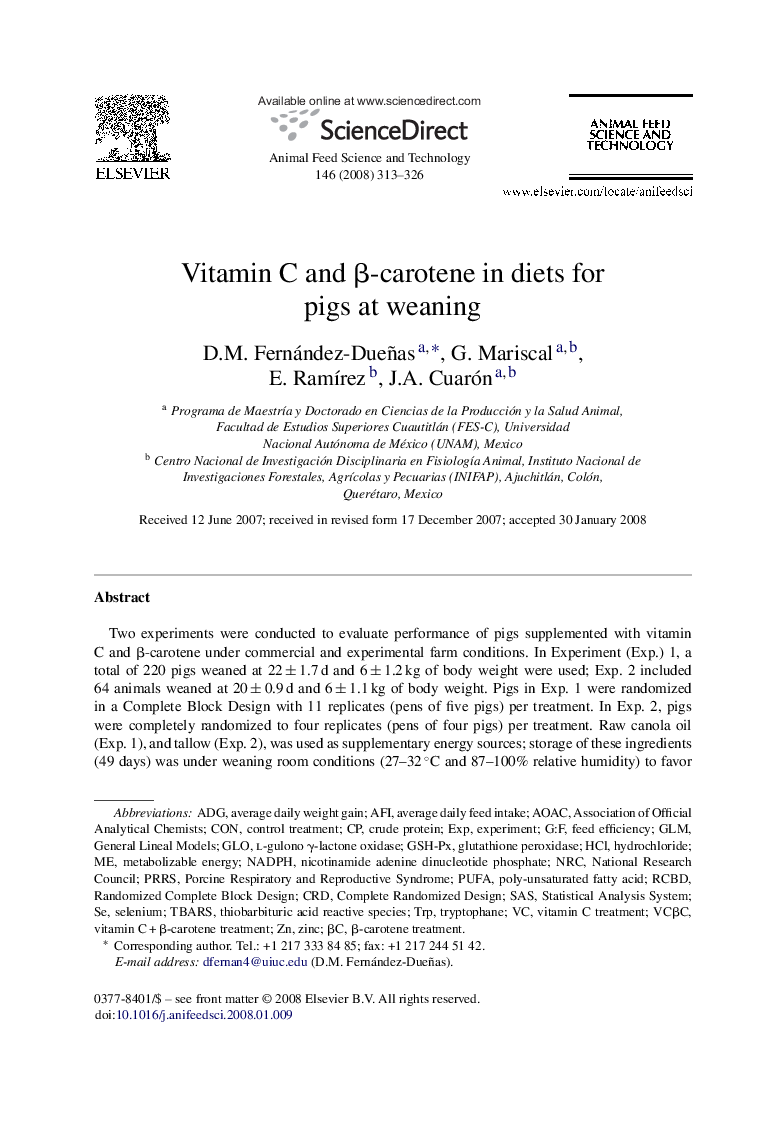| Article ID | Journal | Published Year | Pages | File Type |
|---|---|---|---|---|
| 2420532 | Animal Feed Science and Technology | 2008 | 14 Pages |
Two experiments were conducted to evaluate performance of pigs supplemented with vitamin C and β-carotene under commercial and experimental farm conditions. In Experiment (Exp.) 1, a total of 220 pigs weaned at 22 ± 1.7 d and 6 ± 1.2 kg of body weight were used; Exp. 2 included 64 animals weaned at 20 ± 0.9 d and 6 ± 1.1 kg of body weight. Pigs in Exp. 1 were randomized in a Complete Block Design with 11 replicates (pens of five pigs) per treatment. In Exp. 2, pigs were completely randomized to four replicates (pens of four pigs) per treatment. Raw canola oil (Exp. 1), and tallow (Exp. 2), was used as supplementary energy sources; storage of these ingredients (49 days) was under weaning room conditions (27–32 °C and 87–100% relative humidity) to favor oxidation. Dietary treatments were in both experiments: (1) control (CON); (2) addition of vitamin C, 150 mg/kg and no β-carotene (VC); (3) addition of β-carotene, 350 mg/kg and no vitamin C (βC), and (4) vitamin C, 150 mg/kg and β-carotene, 350 mg/kg (VCβC). Peroxides were determined for canola oil, tallow and diets, while vitamin C and β-carotene were measured only in the final diets. Productive performance was measured in both experiments, Exp. 1 for 24 days and 20 days for Exp 2. In Exp. 1, blood samples were collected from two pigs per pen to determine thiobarbituric acid reactive species (TBARS) and glutathione peroxidase (GSH-Px) activity. In Exp. 1, there were no differences (P>0.130) in average daily feed intake (AFI: 395, 369, 384 and 400 g/d), average daily gain (ADG: 301, 278, 301 and 304 g/d) and feed efficiency (G:F: 769, 758, 783 and 760 g/d), for CON, VC, βC and VCβC treatments, respectively. The GSH-Px activity (P>0.390) and TBARS (P>0.179) in plasma were not different between treatments. In Exp. 2, VC and βC diets apparently reduced AFI (interaction, P<0.05), while a transient β-carotene effect (P<0.05) was evident in ADG during the second half of the experiment (270 vs. 240 g/d), thus resulting in a slight numerical difference in favor of β-carotene and vitamin C dietary additions in G:F. Lack of a clear response to the experimental antioxidants may be explained by the presence in surplus amounts of vitamin E and selenium, plus the regular addition of inorganic antioxidant compounds. Results from the current research do not justify vitamin C and/or β-carotene inclusion to weanling pig diets since no animal performance or antioxidant effect was demonstrated.
